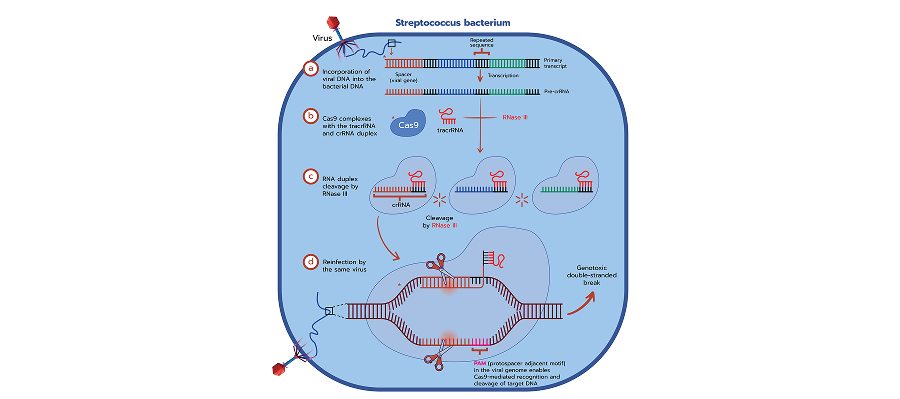CRISPR Gene Editing
CRISPR Gene Editing: A New Era in Precision Medicine
CRISPR (Clustered Regularly Interspaced Short Palindromic Repeats) gene editing is a groundbreaking technology that is revolutionizing biomedical science and therapeutic development. Originally discovered as part of the immune system in bacteria, CRISPR has been adapted into a powerful tool that allows scientists to precisely modify DNA and RNA sequences in living cells. Its simplicity, efficiency, and versatility have made it a cornerstone of modern genetic medicine.
How CRISPR Works
At the core of the CRISPR system is a programmable enzyme—typically a nuclease such as Cas9, Cas12, or Cas13—guided by a synthetic RNA sequence (guide RNA or gRNA) that directs the nuclease to a specific location in the genome or transcriptome. Once at the target site, the nuclease introduces a break in the DNA or RNA, enabling the cell’s natural repair mechanisms to modify the genetic material.
There are two main pathways for DNA repair after CRISPR-mediated cutting:
- Non-Homologous End Joining (NHEJ): This error-prone repair mechanism can result in gene disruption or knock-out, useful for silencing disease-causing genes.
- Homology-Directed Repair (HDR): This high-fidelity repair process uses a DNA template to introduce precise edits, such as gene correction or insertion (knock-in).
Types of CRISPR Systems
Multiple CRISPR variants are under active investigation and development for therapeutic applications:
- CRISPR/Cas9: The most well-known system, ideal for cutting DNA and creating precise insertions or deletions.
- CRISPR/Cas12: Similar to Cas9 but with different targeting properties and potential for more accurate editing with fewer off-target effects.
- CRISPR/Cas13: Targets RNA instead of DNA, useful for gene silencing, transcript editing, and diseases with RNA-level dysregulation.
Advanced CRISPR technologies now include base editors (which enable single-letter changes without cutting the DNA strand) and prime editors (which allow precise rewriting of DNA sequences), significantly expanding the scope of treatable mutations.


Advantages of CRISPR Over Traditional Gene Therapies
Compared to earlier gene therapy approaches that relied on adding new copies of genes, CRISPR offers several distinct advantages:
- Precision: Directly targets and modifies specific gene sequences at their natural location.
- Efficiency: High editing rates with programmable targeting reduce development timelines.
- Versatility: Applicable to a wide range of genetic diseases and cell types.
- Scalability: Modular design enables rapid customization for new therapeutic targets.
These attributes make CRISPR an ideal platform for developing durable, potentially curative therapies across a broad spectrum of diseases.
Therapeutic Applications
CRISPR is opening up new treatment possibilities for both monogenic and complex disorders. Areas of active investigation include:
- Genetic diseases: Thalassemia, sickle cell disease, hemophilia, cystic fibrosis, and inherited retinal disorders.
- Cancer: Engineering immune cells (e.g., CAR-T) to more effectively target tumors.
- Neurological diseases: Modifying genes implicated in ALS, Huntington’s disease, and certain forms of epilepsy.
- Cardiovascular and autoimmune diseases: Modulating gene activity to restore immune and vascular balance.
At Nouvogenes Therapeutics, we are applying CRISPR to develop curative treatments starting with Transfusion-Dependent Thalassemia (TDT). Our platform is designed to correct the disease at its genetic root, aiming to eliminate the need for lifelong transfusions and significantly improve patient outcomes. Beyond TDT, our pipeline includes additional gene therapy programs targeting high-impact diseases with unmet clinical need.
Safety and Innovation
While the potential of CRISPR is immense, ensuring safety and minimizing off-target effects are core to our scientific approach. Nouvogenes Therapeutics is advancing proprietary CRISPR systems and editing modules with enhanced fidelity, delivery precision, and control. We invest heavily in preclinical validation, delivery platform development, and bioinformatics-guided design to ensure that our therapies meet the highest standards of safety and efficacy.
CRISPR technology is more than a scientific breakthrough—it is a foundation for a new generation of precision medicines. At Nouvogenes Therapeutics, we are at the forefront of this transformation, harnessing CRISPR to unlock genetic cures that were once thought impossible.
